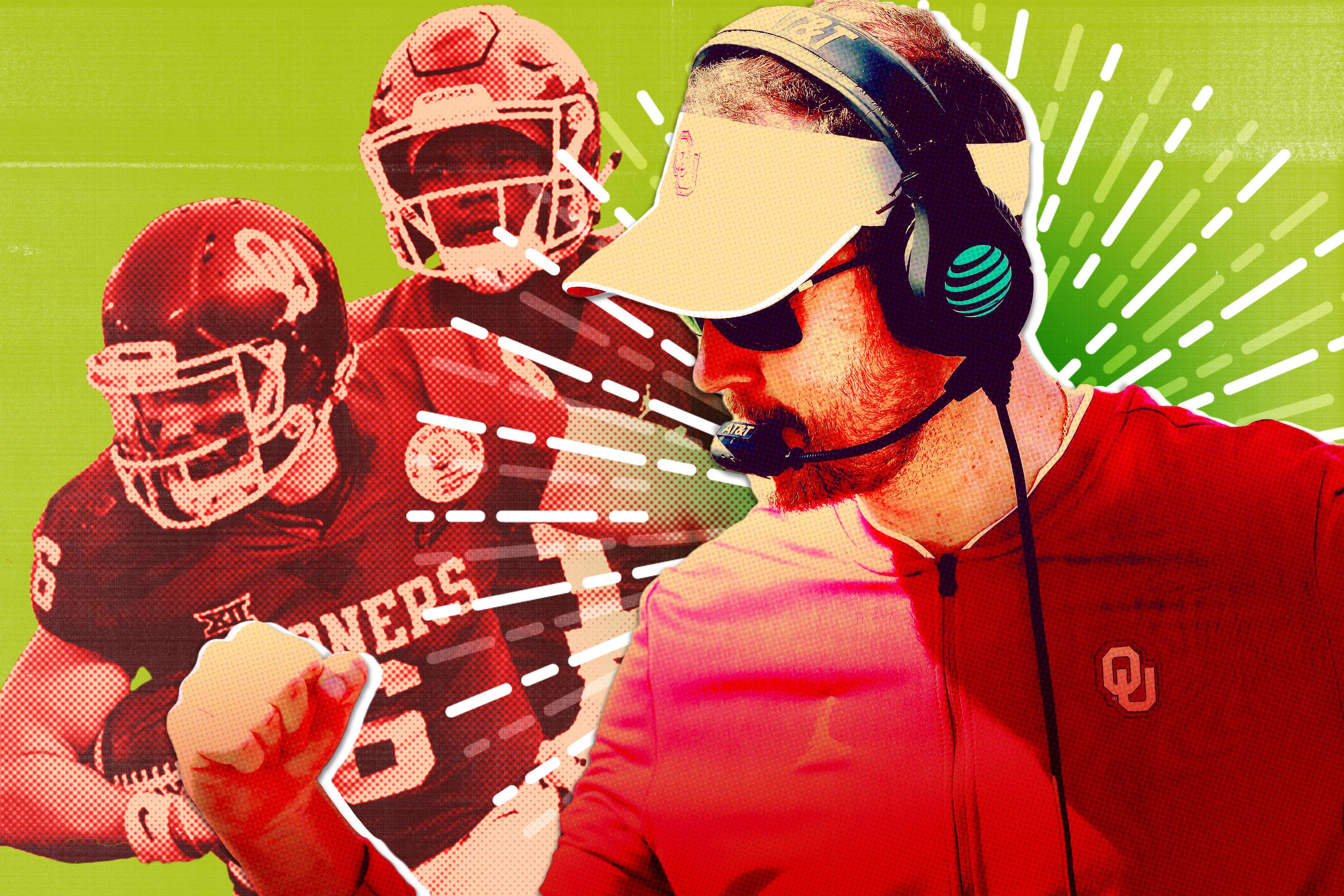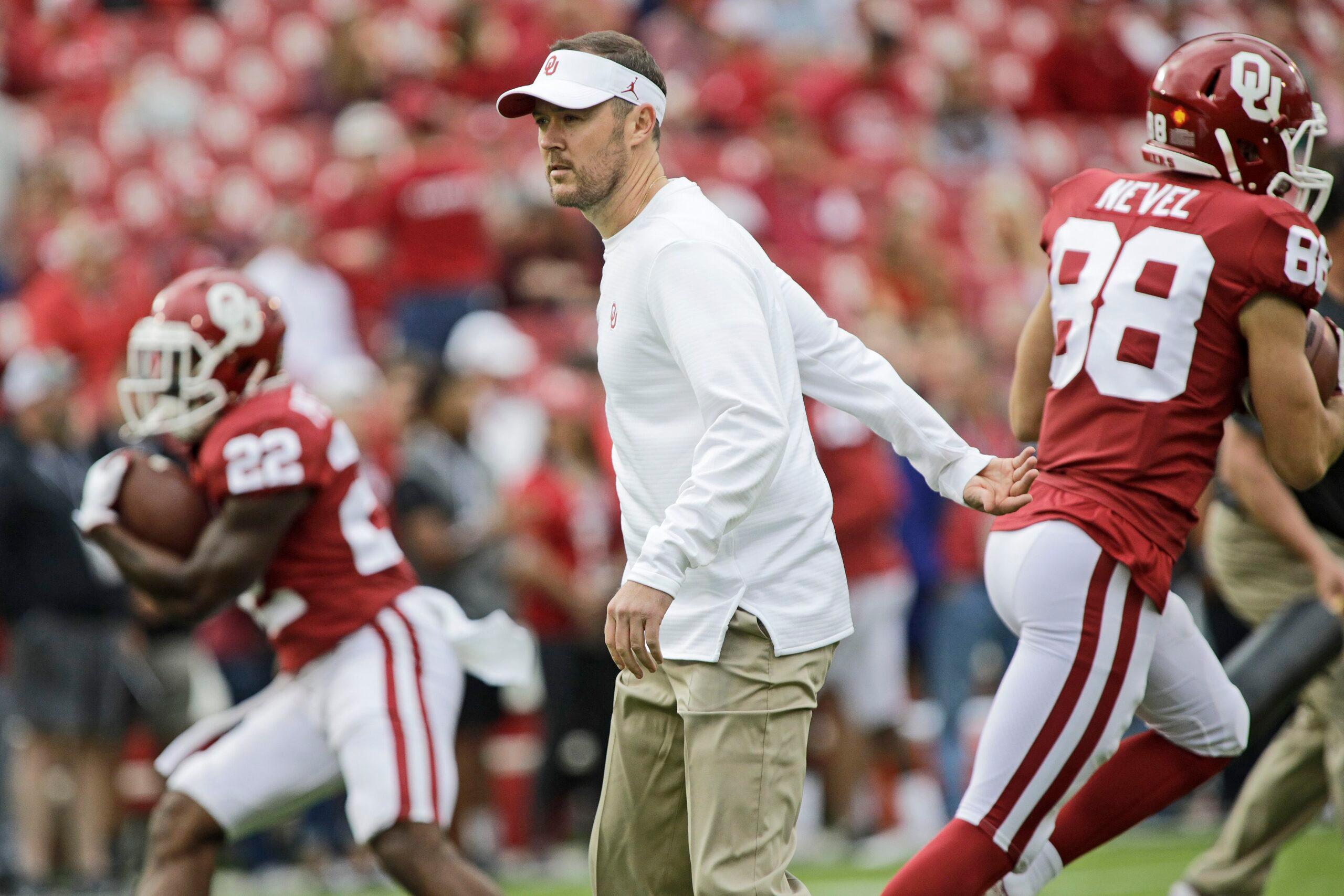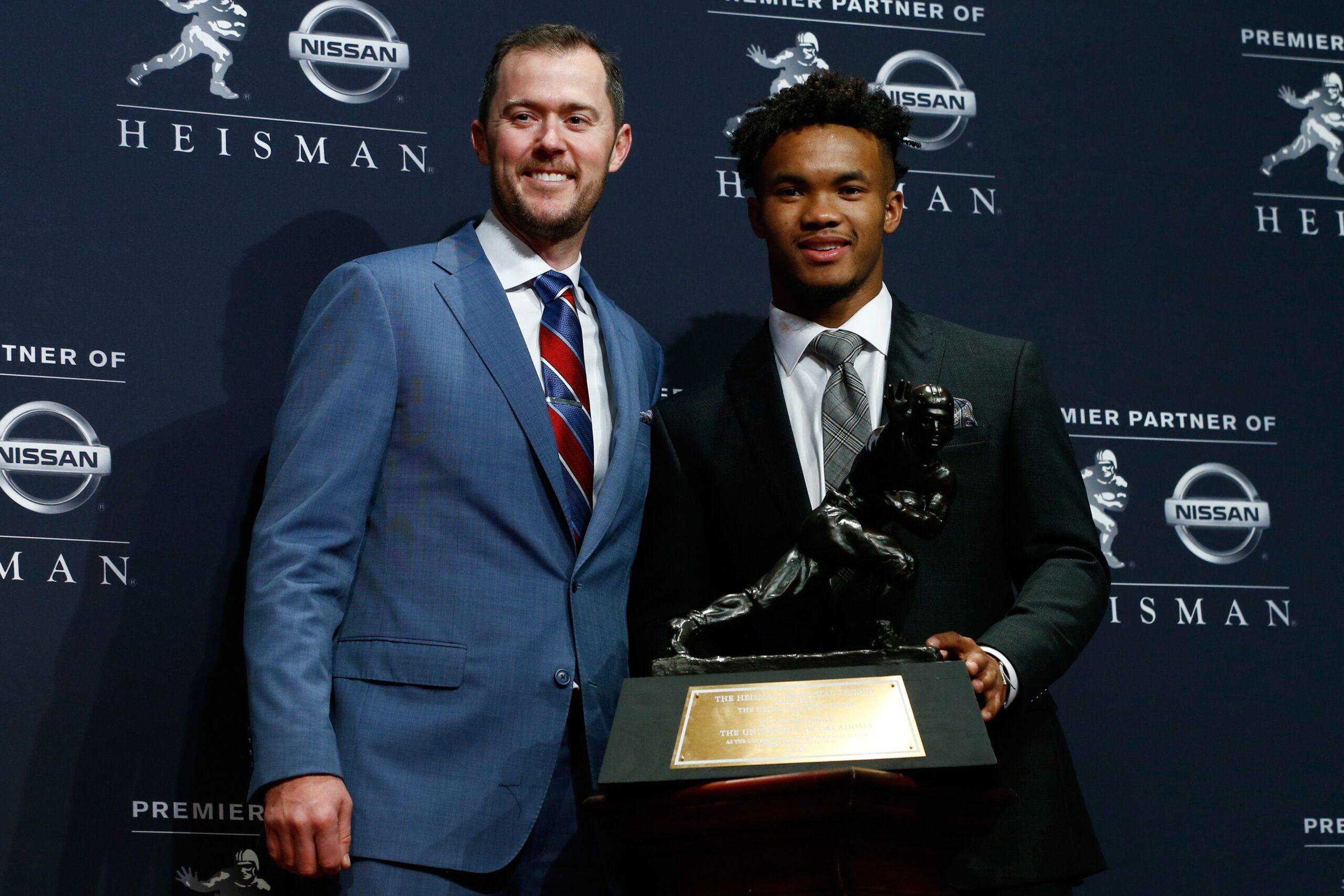Does Lincoln Riley Want to Be the Next Sean McVay or the Next Bob Stoops?
Oklahoma’s coach has become the subject of NFL speculation after producing Heisman-winning QBs in each of the past two seasons. Now he just has to decide if he wants to reign atop a college juggernaut or venture into the unknown.
Players from the same school have won the Heisman Trophy in back-to-back seasons five times throughout college football history. All five were the result of unique scenarios, so let’s take a look at each of them to see what we can learn about the most recent one.
- Yale, 1936 (Larry Kelley) and 1937 (Clint Frank): The second and third Heisman Trophy winners reveal that college football was much, much different back in the day. Both were members of the Skull and Bones society. Kelley went on to be a high school teacher, while Frank founded an advertising agency. Maybe Frank should’ve invented the Nissan “Heisman House” campaign so he could have gotten paychecks for having won a prestigious trophy as a college student instead of having to do a regular-person job.
- Army, 1945 (Doc Blanchard) and 1946 (Glenn Davis): These repeat Heisman winners reflect Army’s college football dominance in the 1940s. In the present day, Army and its fellow service academies face a distinct challenge—while players from other schools tend to make the NFL or go pro in something other than sports, athletes from service academies commit to serve in the United States military after graduation. During World War II, every able-bodied American man had to register to serve in the military, so it was a good idea to go to service academies and get an officership if you were smart and strong enough to pull it off. In 1945 Army went 9-0, outscoring its opponents 412-46; in 1946 Army went 9-0-1, outscoring opponents 263-80.
- Ohio State, 1974 (Archie Griffin) and 1975 (Archie Griffin): Griffin rushed for 3,145 yards over two seasons. One way for a school to win back-to-back Heismans is to have the same guy win it twice.
- USC, 2004 (Matt Leinart) and 2005 (Reggie Bush): USC finished 13-0 in 2004 and was 12-0 in 2005 at the time when the Heisman was awarded. As such, voters dutifully gave the award to the best player on college football’s best team. In 2004 that was Leinart, the quarterback, who won the trophy while Bush, the running back, came in fifth. In 2005 Bush established himself as the best player on the team, and won a higher percentage of Heisman votes than any player in the trophy’s history. (The Heisman Trust has since taken his award away because, uh, Bush had a car he wasn’t supposed to.)
- Oklahoma, 2017 (Baker Mayfield) and 2018 (Kyler Murray): That Murray and Mayfield have won the Heisman in consecutive years is unprecedented in myriad ways. This isn’t the 1930s, when future high school teachers could win the award. This isn’t the 1940s, when Army possessed such a talent advantage over the rest of college football that the sport was barely fair. This isn’t an example of one player dominating the sport over two seasons, like Griffin at Ohio State, or a dynasty having two separate stars get their due, like USC in the early 2000s. Mayfield and Murray play the same position for a school that didn’t win the national championship last year and faces an uphill battle to win it this year. (The Sooners play Alabama in a College Football Playoff semifinal on Saturday, and, well, Alabama could go down as one of the greatest teams of all time.) And yet both have been considered exceptional enough as standalone talents to take home college football’s most recognizable individual honor.
The man largely responsible for this? Oklahoma coach Lincoln Riley. Last season was Riley’s first as a head coach, and under his guidance Mayfield set the all-time FBS records for passer-efficiency rating (198.9) and yards per pass attempt (11.5). In Riley’s second season as a head coach, Murray broke Mayfield’s records for passer efficiency rating (205.7) and yards per attempt (11.9). Riley has never been the head coach of a Sooners team that didn’t produce the most efficient quarterback in the sport’s history.
Riley’s offensive wizardry doesn’t take away from what Mayfield and Murray accomplished. Both players have one-of-a-kind skill sets and backstories. Mayfield was a walk-on who never stopped believing in himself—in the grand scheme or on any individual snap, as he perpetually extends plays while searching for a man downfield. Murray is an explosive speedster who was picked in the first round of this year’s MLB draft. The biggest similarity between the two is that both transferred into Riley’s program and became superstars.
What happens next for Riley is intriguing. He excels at player development, and is driving the pace of offensive scheme innovation in football. At 35, he already has a college football dream job. But the NFL is clamoring for him, and the more Heismans that he adds to Oklahoma’s trophy case, the more appealing he becomes. As the Sooners prepare to take on Alabama, Riley’s future is as big a talking point as his present: Will he be content to continue breaking records at Oklahoma? Or will he seek out something bigger?

The words “Air Raid” make people act strangely. Some people sneer at them like they’re scheme steroids—sure, this system works, but is it legitimate to win using the Air Raid? Some people assume it’s a cheat code: Any coach can show up, call five Air Raid plays, and suddenly hang 50 points.
Riley’s career was born from the Air Raid. He played quarterback under Mike Leach at Texas Tech—well, he never played in games, but he was on the Red Raiders roster—and got his first coaching job under Leach in 2003. One might see Riley’s résumé and the fact Oklahoma averages 49.5 points per game and assume that Riley is running the prototypical Air Raid. You’d be wrong. Here’s a clip of Oklahoma running the dang triple option out of a spread formation:
At Texas Tech, Leach used the Air Raid to make up for glaring talent deficiencies. He knew programs like Texas, Texas A&M, and Oklahoma would get the most sought-after quarterbacks, running backs, and linemen in the region. So he schemed a system that essentially abandoned the run game, only asked QBs to make throws to wide-open players, and only asked linemen to hold blocks for fractions of a second. His receivers got open not because they were quicker or had superior moves than other receivers, but because they knew every route in the Red Raiders’ tree like they’d grown up running it. They could feel how to get open.
At Oklahoma, you don’t need a scheme to make up for these sorts of talent disadvantages. You’re one of the schools that the Air Raid was designed to beat. When Riley arrived in Norman in 2015, his running backs were Joe Mixon and Samaje Perine—both eventual NFL draft picks. Oklahoma has a proud tradition of churning out elite offensive linemen; in the years before Riley showed up, the Sooners featured future Pro Bowlers Trent Williams and Lane Johnson, and Riley worked with consensus All-American Orlando Brown in 2017. Oklahoma’s current left guard, Ben Powers, was named a consensus All-American this month. And suffice it to say, the school hasn’t had trouble bringing in quarterbacks. Murray was a five-star prospect in 2015 (though he committed to Texas A&M before transferring to Norman), and Oklahoma signed the top QB in the 2019 class, Spencer Rattler. (Like 17 species of rattlesnake, he’s from Arizona. I can’t believe he resisted the urge to play for Florida A&M, although Oklahoma has literally lost players named “Boomer” to Oklahoma State and Tulsa, so maybe recruits don’t care about nominative determinism as much as I do.)
You could run the Air Raid at Oklahoma, but you’d be wasting your talent. So Riley has invented a version of the Air Raid that maximizes the abilities of the NFL-caliber players stationed at every position on the field. As SB Nation wrote earlier this week, Riley’s offense is “innovative even by the increasingly innovative standards of modern spread offense.”
According to Football Outsiders’ S&P+, Oklahoma not only boasted the second-best passing offense in college football this year; it also had the best rushing offense. Murray broke Mayfield’s record for yards per pass attempt while the Sooners simultaneously ranked second nationally in yards per carry (6.7). Oklahoma’s defining play under Riley might actually be a run: the counter, an age-old rushing tactic. Note how the pulling guards and tackles provide no indication of whether the play will be a typical running back counter, a QB keeper, an option play, a designed pass, or an RPO:
It’s difficult enough for defenses to contain the counter in its original form. When Riley packages it with play-action and RPOs, it becomes virtually unstoppable. Riley uses Air Raid principles to get his receivers wide the hell open, and then uses one of the best offensive lines in the country and future pro running backs to establish a dominant ground game. That makes it easier for Oklahoma’s receivers to get wide the hell open on passing plays.
These Sooners have the best offense in modern college football history. (Even better than Army during literal World War II.) They’re stacked across the depth chart, and Riley has combined the game-breaking nature of the Air Raid with a scheme custom-built for his talent. He doesn’t force his players to adapt to a rigid system; he takes quarterbacks as different as Mayfield and Murray and builds offenses that cater to what they do best.
What Riley does works really well for Oklahoma. His ability to adapt his scheme to his talent has everybody else in the football world wondering Where else would it work?

Riley’s ascension to the Oklahoma top job came about under unusual circumstances. In June 2017, longtime Sooners head coach Bob Stoops retired out of the blue with less than three months left until the start of football season. With no time to conduct a full search, Oklahoma turned to its then-33-year-old offensive coordinator, appointing Riley as the youngest head coach in college football. (Even after two years on the job, he’s still the second-youngest FBS head coach.)
There were so many questions. Was Stoops headed to the NFL? (No, it turns out. His name hasn’t popped up in any coaching searches in more than a year, and it genuinely seems like he’s done.) Was Riley ready for a head-coaching gig? (Yes.) Would the abrupt change throw the program into disarray by having it head into such an important season with a noob at the helm? (No. Oklahoma made the College Football Playoff under Riley.) The biggest problem with the transition was that Stoops’s exit didn’t give Riley enough time or clout to fire Stoops’s disappointing younger brother, Mike, as the team’s defensive coordinator.
Now, what seemed like a spur-of-the-moment decision by Stoops appears to have been a considered choice made with long-term sustainability in mind. Stoops didn’t just wake up one summer day and decide that he’d rather relax on the porch and drink lemonade than go to work. By retiring so close to a new season, he essentially forced Oklahoma to hire one of his protégés rather than pursue a big-name coach during a national search. I suspect he knew how good Riley was and wanted to protect his legacy. For Stoops, Oklahoma was a lifetime gig. It was the first head job he’d ever had, and after winning a national title in his second year there, he was given the reins of the place.
Perhaps Riley will want the same thing. That Stoops hand-selected him gave him a ton of instant credibility, and back-to-back Heisman winners and playoff appearances have fully cemented his status among the college football coaching elite. If he wins a title within the next few seasons, he’ll land one of the biggest contracts in coaching and have airtight job security at one of the most storied programs in America by the time he’s 40.
But the NFL keeps calling. ESPN’s Kirk Herbstreit says 28 pro teams have texted him about Oklahoma’s offense, although it’s not very clear whether texting Herbstreit is any team’s preferred method of vetting a coach. Being a successful college coach does not make one a successful NFL coach—ask Nick Saban, who’s the G.O.A.T. in the college ranks and a goat in the pros. (Actually, don’t ask him. He’s already ornery enough in press conferences.) Saban’s strengths are recruiting and building airtight defenses. You literally can’t do one of those in the NFL, and the second seems unnecessary in an era defined by offense. But Riley did not generate back-to-back Heisman winners through recruiting or defensive acumen. He did it through QB development and offensive game-planning, the two qualities NFL teams most covet. We’re in an era when every team wants its own Sean McVay. Riley seems like he could legitimately replicate McVay’s success.
On Thursday, Riley told reporters that he’s not particularly interested in heading to the pros “right now.” Frankly, it would be messed up if two days before the College Football Playoff he said, “Yeah, I’m gonna go coach the Browns.” (Intriguingly, Murray also said he’s not planning to enter the NFL draft “right now.” Maybe both of their futures are set; maybe they’re both good at technically not lying.) But I don’t think the NFL talk will ever die down for Riley. His scheme is what pro teams want. His players are who pro teams want: Mayfield was the no. 1 pick in the 2018 draft.
I’m curious to see what Riley can do in the pros, but I’m also curious to see whether he can become the first person ever to coach back-to-back-to-back Heisman winners. Two in a row has been done before; three in a row is unprecedented. I’m already sitting on the #Rattler4Heisman hashtag.